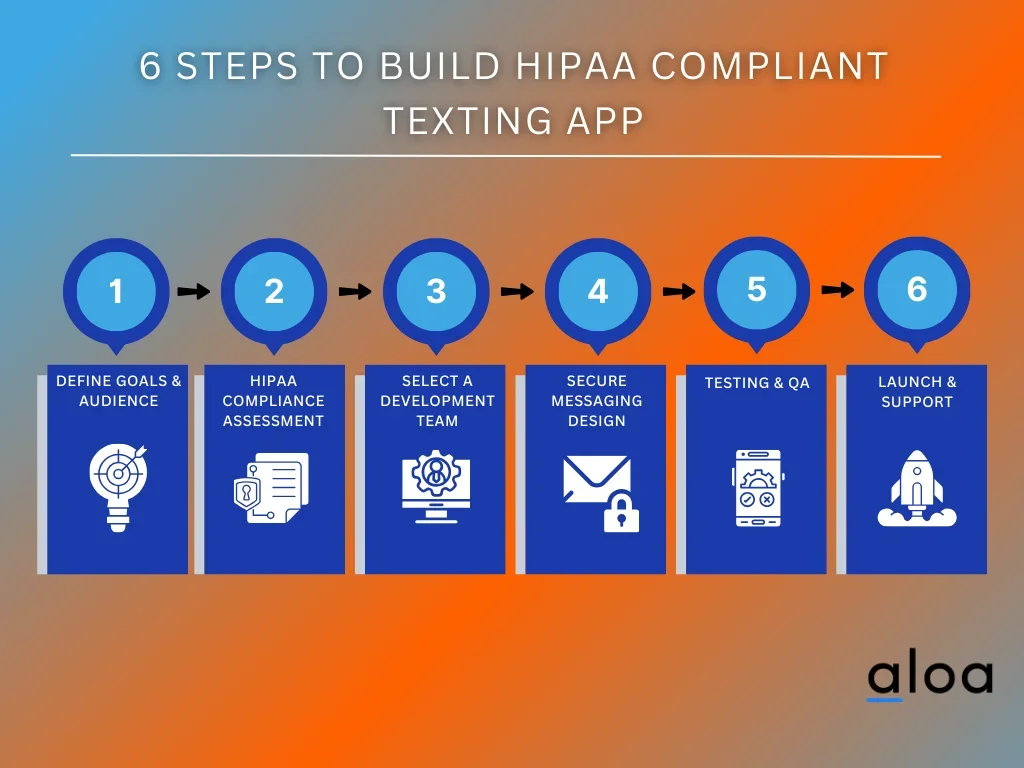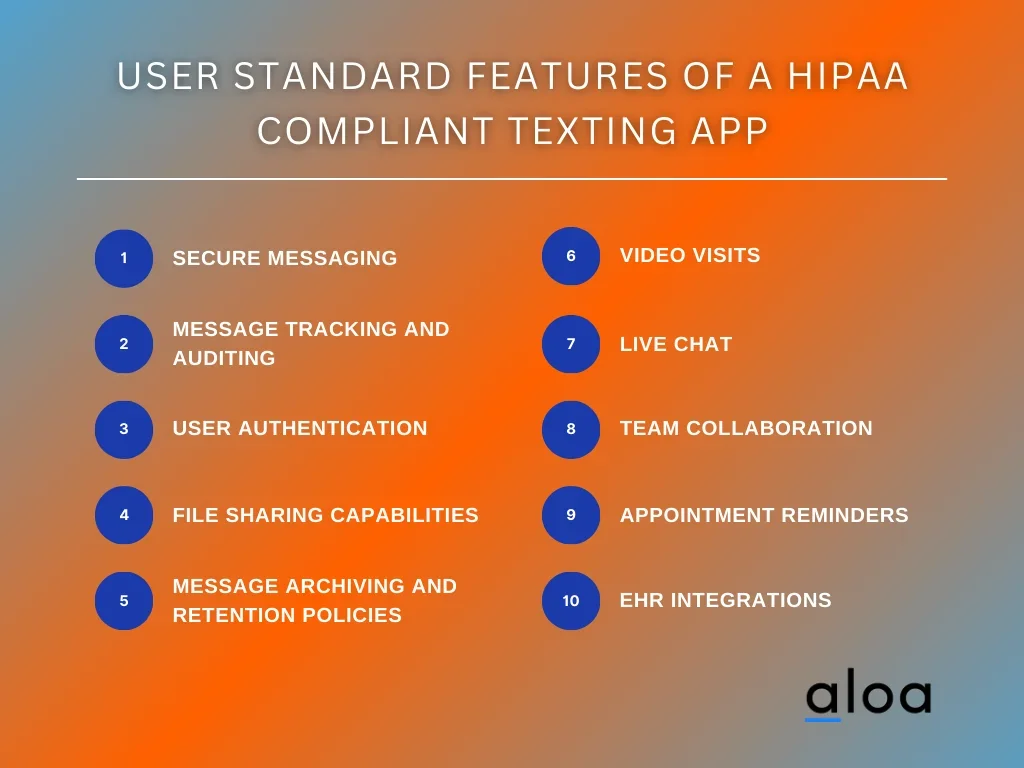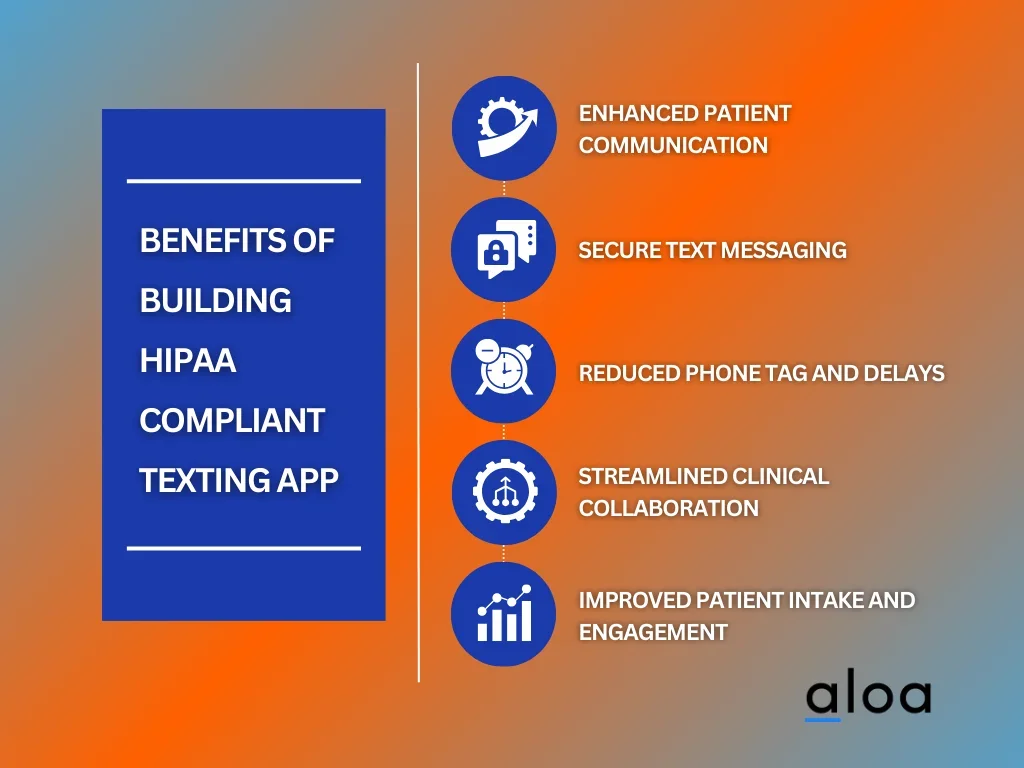HIPAA compliant texting app is a crucial component of healthcare communication. Ensuring the security and privacy of health information is crucial, given the sensitive nature of patient data. With the ever-increasing reliance on text messaging for patient engagement and communication, healthcare providers and organizations must adapt to the changing landscape while adhering to strict regulatory standards.
Aloa, an expert in software outsourcing, is here to assist businesses and startups in navigating the challenges of HIPAA compliance. We understand the importance of patient engagement and communication in the healthcare industry and offer solutions tailored to healthcare providers, professionals, and organizations.
In this blog, we will explore the development process for HIPAA compliant messaging apps, addressing the specific needs of healthcare communication, and we'll dissect the core features. Afterward, you will understand how to build a HIPAA compliant texting app that enhances patient experience, facilitates secure communication among healthcare teams, and safeguards sensitive patient information.
Let's dive in!
6 Steps to Build HIPAA Compliant Texting App
Building a HIPAA compliant texting app is crucial for secure healthcare communication. Ensuring the privacy and security of patient information is a top priority in the healthcare industry. Let's explore the six essential steps to develop a HIPAA compliant messaging app.

Step 1: Define Your Objectives and Target Audience:
In building a HIPAA compliant texting app, you must define your objectives and pinpoint your target audience meticulously. These two factors lay the foundation for a successful development process and ensure that your app aligns with the specific requirements of healthcare communication.
Begin by identifying your app's primary goals and objectives. Clarify whether your app serves one or both of these purposes. Understanding your objectives will guide the development process and feature selection. Determine whether your app caters primarily to healthcare professionals, patients, or a combination. Here are some key questions that help you define your objectives and target audience:
- What specific challenges does your target audience face in their communication needs?
- Are there any unique preferences or requirements specific to your target users?
- How will your app differentiate itself from existing solutions in the market?
- Will your app require customization options to adapt to different healthcare specialties?
- How can you ensure a seamless user experience while maintaining HIPAA compliance?
By addressing these questions and thoroughly defining your objectives and audience, you can pave the way for a HIPAA compliant messaging app that effectively addresses the communication needs of healthcare professionals and patients while adhering to regulatory standards.
Step 2: HIPAA Compliance Assessment
To ensure the development of a HIPAA compliant texting app, a comprehensive assessment of the Health Insurance Portability and Accountability Act (HIPAA) regulations is paramount. This step lays the foundation for understanding and adhering to the stringent compliance requirements set by HIPAA. Begin with a comprehensive examination of HIPAA regulations rules to grasp their intricate requirements:
- Privacy Rule: Understand how patient data is handled and prioritize safeguarding patient privacy.
- Security Rule: Apply technical, physical, and administrative safeguards to protect ePHI.
- Breach Notification Rule: Develop protocols for prompt data breach identification and reporting, complying with HIPAA requirements.
Consider various compliance factors, such as:
- Data Encryption: Encrypt data transmission and storage for enhanced security.
- Access Controls: Implement robust user authentication and access restrictions.
- Audit Trails: Create user activity logs for monitoring and data access tracking.
- Data Retention: Establish data retention policies per HIPAA, including secure data disposal when no longer necessary.
By conducting a rigorous HIPAA compliance assessment and identifying the relevant sections, you set a strong foundation for building a texting app that prioritizes patient data privacy and security, aligning with the healthcare industry's regulatory standards.
Step 3: Select a Development Team
Selecting the right development team is critical in building a HIPAA compliant texting app. Your choice of developers can significantly impact the app's success and ability to meet healthcare communication's stringent requirements. Here's why it's important:
Opt for a team of app developers specializing in healthcare software development. These experts possess a deep understanding of the unique challenges and intricacies of the healthcare industry, enabling them to design solutions tailored to healthcare professionals' needs.
Moreover, ensure that your chosen developers are well-versed in HIPAA compliance. They should comprehensively understand the Health Insurance Portability and Accountability Act. This knowledge ensures your app functions effectively, safeguards patient data, and maintains regulatory compliance.
Consider partnering with Aloa as your development partner. With their expertise, you can confidently navigate the complex terrain of healthcare app development, knowing that you have a dedicated team focused on your success and the security of patient information.
Step 4: Design Secure Messaging Features:
Designing secure messaging features is critical in building a HIPAA compliant texting app. To ensure that your app adheres to HIPAA standards, paying close attention to security and privacy considerations is essential. Here are the things to consider when designing secure messaging features:
- End-to-end Encryption: Implement robust encryption for all messages transmitted through your app. This encryption ensures that messages are securely scrambled at the sender's end and only decrypted at the recipient's end, preventing unauthorized access during transmission.
- User Authentication: Incorporate robust user authentication mechanisms, such as two-factor authentication (2FA) or biometric authentication, to verify users' identities. This adds an extra layer of security, ensuring that only authorized individuals can access the app.
- Secure Message Storage: Store messages and attachments securely, following HIPAA-compliant data storage guidelines. Data should be encrypted at rest and in transit, and you should employ data retention policies to manage message storage effectively.
- User Access Controls: Implement user access controls to define who can access specific patient information and communication threads. Role-based access control (RBAC) helps ensure that only authorized individuals can view and interact with patient data.
- Audit Trails: Create comprehensive audit trails that log user activities, including message sending, access to patient data, and system changes. As HIPAA requires, these audit logs are crucial for monitoring and tracking user interactions.
By incorporating these secure messaging features and considerations, your HIPAA compliant texting app can offer healthcare professionals and patients a safe and reliable communication platform while meeting the healthcare industry's stringent privacy and security requirements.
Step 5: Testing and Quality Assurance
Testing and Quality Assurance are pivotal in developing a HIPAA compliant texting app, ensuring it meets the stringent security and compliance standards required in the healthcare industry. Here's an expanded look at this crucial step:
- Rigorous Testing: Rigorous testing is imperative to identify and rectify any security vulnerabilities or compliance issues. This includes conducting extensive testing at every stage of app development to catch potential flaws.
- Penetration Testing: Penetration testing and vulnerability assessments are essential components of testing. By simulating real-world attacks, you can assess the app's security posture and identify weak points that need strengthening.
- Cross-Platform Functionality: Ensuring the app functions seamlessly across various devices and platforms, including mobile devices, is crucial. Compatibility with different operating systems and screen sizes is vital for a broad user base.
- Performance Testing: Comprehensive performance testing is necessary to evaluate the app's responsiveness and efficiency. Particular attention should be paid to message delivery, as timely communication is critical in healthcare, and data integrity should be maintained throughout.
- Scalability Testing: Consider scalability testing to assess how the app handles increasing users and data volumes. Ensuring that the app remains robust as user demands grow is vital for long-term success.
By adhering to these testing and quality assurance practices, you can create a HIPAA compliant messaging app that meets the highest security and compliance standards and delivers a seamless and reliable user experience in the healthcare industry.
Step 6: Launch and Ongoing Support
When your HIPAA compliant texting app reaches the point of readiness, the launch phase becomes pivotal. It necessitates a meticulous approach that begins with a well-structured marketing strategy. Identify your target audience within the healthcare sector and create tailored messages that resonate with their specific needs and challenges. To generate awareness and interest, employ a multi-channel approach, including social media, industry events, and healthcare publications.
Furthermore, an effective user onboarding strategy ensures healthcare professionals and organizations can seamlessly adopt your app. Simplify the registration process and provide clear, user-friendly guides or tutorials. A responsive customer support system should accompany this phase to swiftly address any inquiries or concerns. Offering comprehensive training resources, such as webinars or video tutorials, reinforces users' understanding of the app's capabilities and the significance of HIPAA compliance.
Standard Features of a HIPAA Compliant Texting App
HIPAA compliant texting apps offer comprehensive features to facilitate secure communication between healthcare professionals and safeguard sensitive patient information. Let's delve into the essential features categorized for administrators and users.

Features for Admin
Administrators play a crucial role in managing and maintaining the integrity of a HIPAA compliant messaging app. Here are ten key features that empower administrators to ensure HIPAA compliance and streamline healthcare communication:
- User Management: Administrators can create, manage, and deactivate user accounts. This feature controls who can access the app, ensuring only authorized personnel can access patient information.
- Access Control: HIPAA compliant messaging apps enable administrators to set user permissions and access levels. This ensures that users can only view and interact with the information relevant to their role, limiting unauthorized access.
- Secure Message Archiving: Messages exchanged within the app are securely archived, facilitating compliance with retention policies and audit requirements. This feature ensures that communication history is readily available when needed.
- Integration with EHR Systems: Seamless integration with Electronic Health Record (EHR) systems allows administrators to link patient records with corresponding conversations. This enhances the continuity of care and simplifies data retrieval.
- Incident Response and Breach Notification: Administrators can swiftly respond by initiating breach notification procedures in the unfortunate event of a data breach or security incident. This timely action is essential for compliance with federal law.
- Compliance Reporting and Auditing Tools: HIPAA compliant texting app provides reporting and auditing tools that enable administrators to monitor user activities, track message access, and ensure adherence to HIPAA regulations.
- Mobile Device Management: To maintain control over the devices used for communication, administrators can implement mobile device management (MDM) policies. This ensures that data remains secure even on personal devices.
- Role-Based Messaging: This feature allows administrators to define message distribution based on roles within the healthcare organization. It ensures that messages reach the right people for effective care coordination.
- App Updates and Security Patches: Admins can oversee app updates and security patches to keep the texting app current and protected against potential vulnerabilities, contributing to overall security.
- Training and Support: A HIPAA compliant messaging app typically offers training resources and dedicated support to help administrators and users understand and utilize the platform effectively. Proper training is essential for ensuring compliance and optimal usage.
Features for User
Users, including healthcare professionals, play a vital role in using HIPAA compliant texting apps to provide quality patient care and streamline communication. Here are ten essential features designed to enhance their experience:

- Secure Messaging: Users can securely exchange text messages, images, and documents within the app. End-to-end encryption ensures that sensitive information remains confidential.
- Message Tracking and Auditing: Users can access message tracking and auditing features to confirm delivery and receipt. This feature is essential for accountability and compliance.
- User Authentication: To prevent unauthorized access, users must authenticate themselves before accessing the app. This multi-factor authentication adds an extra layer of security.
- File Sharing Capabilities: Users can share important files such as test results, images, or documents securely through the app, eliminating the need for less secure methods like email.
- Message Archiving and Retention Policies: Users benefit from message archiving, ensuring that communication history is stored securely and adheres to compliance requirements for data retention.
- Video Visits: Some HIPAA compliant texting apps may offer integrated video visit capabilities, enabling healthcare professionals to conduct virtual patient appointments in a secure environment.
- Live Chat: Real-time chat functionality allows users to engage in live discussions, enhancing quick decision-making and collaboration among healthcare team members.
- Team Collaboration: Users can create group chats and collaborate with other healthcare professionals, streamlining care coordination and facilitating team communication.
- Appointment Reminders: Automated appointment reminders help users keep patients informed about upcoming appointments, improving patient engagement and reducing no-shows.
- EHR Integrations: Integration with Electronic Health Record (EHR) systems enables users to access patient information seamlessly within the app, improving the efficiency of patient care.
Benefits of Building HIPAA Compliant Texting App
Patient information, treatment plans, and medical updates must be shared swiftly and securely among medical professionals. In this context, a HIPAA compliant texting app emerges as a powerful tool, offering numerous advantages for healthcare providers and organizations.
Let's explore five key benefits of developing such an app.

Enhanced Patient Communication
A HIPAA compliant messaging app facilitates real-time communication between patients and healthcare providers. Patients can quickly contact their doctors or nurses for appointments, questions, or updates. This fosters a stronger patient-provider relationship, improving patient satisfaction and engagement.
Secure Text Messaging
Privacy and security are top priorities in healthcare. With secure texting, medical professionals can exchange sensitive patient data, such as test results and treatment plans, without worrying about unauthorized disclosure. This secure platform ensures that patient information remains confidential and protected.
Reduced Phone Tag and Delays
Traditional phone calls often result in time-consuming phone tags or missed calls. A HIPAA compliant messaging app enables instant messaging, reducing back-and-forth delays. Medical professionals can quickly coordinate care, consult with colleagues, and respond to patient needs, ultimately improving efficiency.
Streamlined Clinical Collaboration
In a healthcare setting, collaboration among team members is crucial. A texting app tailored to HIPAA compliance allows for seamless clinical collaboration. Physicians, nurses, and support staff can easily share insights, coordinate care plans, and discuss patient cases in real time, leading to more effective patient care.
Improved Patient Intake and Engagement
Efficient patient intake is essential for healthcare practices. A HIPAA compliant texting app can streamline the intake process, allowing patients to complete forms and provide medical histories electronically. Moreover, automated appointment reminders and follow-up messages enhance patient engagement and adherence to treatment plans.
Key Takeaway
Building a HIPAA compliant texting app in healthcare is crucial to ensure secure and confidential communication between patients and healthcare providers. By following the outlined development process and implementing essential features, healthcare organizations can achieve compliance with the Health Insurance Portability and Accountability Act (HIPAA) regulations.
This compliance safeguards sensitive patient information, reduces legal risks, and ensures efficient data sharing and collaboration within the healthcare industry. The benefits of a HIPAA compliant messaging app include improved patient-provider communication, enhanced security and privacy, and streamlined healthcare workflows.
For more information on how to develop a HIPAA compliant texting app and its impact on healthcare communication, contact us at [email protected]. We are here to assist you in understanding the importance of HIPAA compliance and guide you through the development process to create a secure and efficient messaging solution for healthcare.

